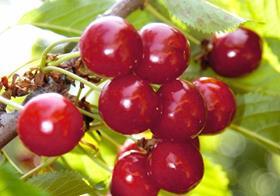
A resurgence in demand for cherries combined with a smaller than average European crop has led to a strong market for the fruit across major EU markets this season.
Reports from across the continent suggest the overall volume of cherries available has been significantly below the level of demand, with Belgium, Czech Republic, Croatia, France, Germany and the Netherlands all seeing their production fall in 2012, resulting in good prices in many key consumer markets.
In the UK, where the volume of domestically grown cherries sold during the country's eight-week season has rocketed over the past 12 years – from 400 tonnes in 2000 to around 2,000 tonnes this year – supply remains some way behind demand, sustaining good demand for imported fruit.
According to the latest data, British shoppers are in fact expected to purchase around 9,600 tonnes of cherries during those eight weeks, with foreign suppliers making up for the shortfall in local supply.
As a result, growers in the UK are reportedly planning to more than double the size of their crop to an estimated 4,000-5,000 tonnes by introducing new tree types and developing new methods of production to boost yields.
In the Netherlands, meanwhile, Frits Vossen of fresh produce trading company Kervo told AGL.nl that the balance of supply and demand had been good in mainland Europe this season.
'The sweet cherry season is going reasonably well,' he confirmed. 'The quality of sweet cherries was pretty good, but there were considerably less volume, resulting in good demand and good prices.'
Voseen added that demand didn't seem to be affected by the recent poor weather seen across much of north-western Europe. 'The weather has little impact on the consumption of sweet cherries. During the season people want to eat them anyway.'
British boom
Back in the UK, the country's largest food retailer Tesco said it had been working closely with growers around the country and encouraging them to produce more of consumers' favourite varieties, which are sweeter and fresher, and can be brought to store in about 48 hours.
Tesco stonefruit buyer Marie-Claire Lisk explained: 'Shoppers tell us that they like British cherries best but demand far exceeds supply at the moment, which is why we've been working with growers on a major planting programme to increase volume.
Weather permitting, she said, Tesco was aiming to sell twice as many British cherries compared with last year, offering more of the most popular homegrown varieties such as Penny, Regina and Kordia.
'But the best news is that by the end of the decade we should be able to completely meet demand for home-grown cherries for the whole British season,' she continued. 'That's an amazing turnaround from just ten years ago.'
English cherries were once the UK's number one summer fruit and outsold strawberries, but poor weather, high labour costs and old-fashioned picking methods apparently saw volumes of the country's cherries greatly diminish over the last 50 years.
Imports of cheaper fruit from Turkey, Spain and the US also contributed to the decline in UK production, Lisk suggested, adding that the trend showed signs of being reversed.
'More and more British growers are now seeing higher yields by using dwarf root stock, grafted onto new tree varieties,' she noted. 'These produce much smaller trees which can be grown in plastic tunnels, creating a micro-climate with temperatures similar to the Mediterranean.'
Those new, smaller cherry trees can be picked by workers on foot rather than on ladders, contributing to a reduction in input costs.
'This is enabling English cherries to compete with foreign rivals for the first time in many decades,' Lisk added.



